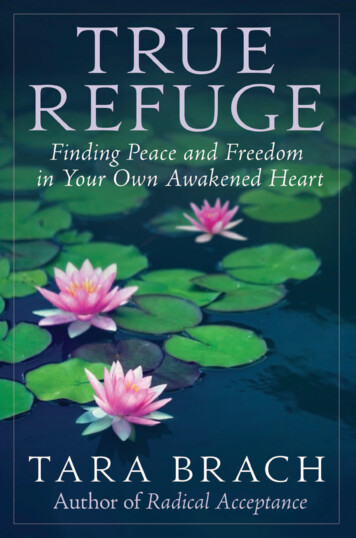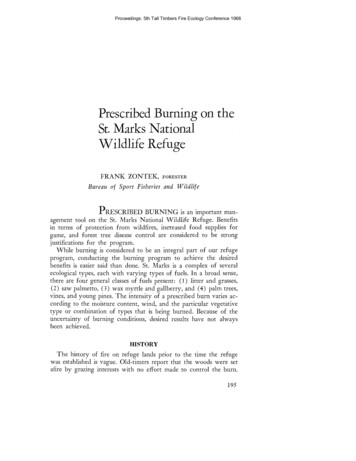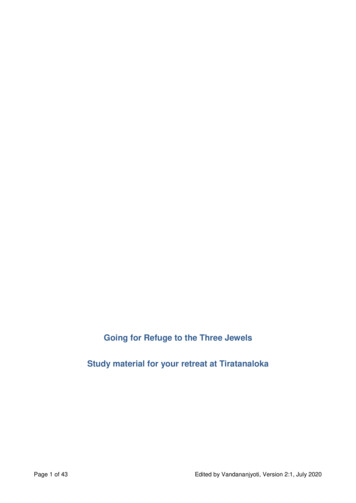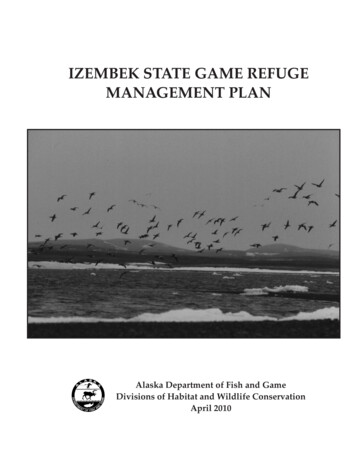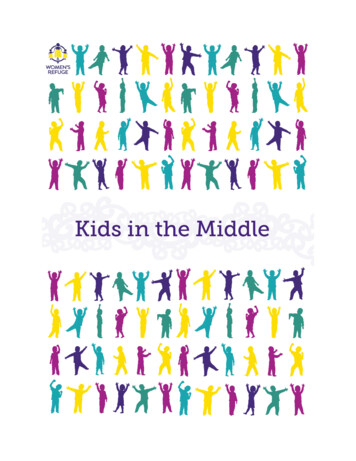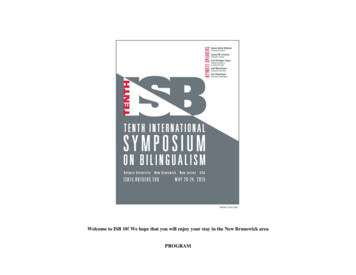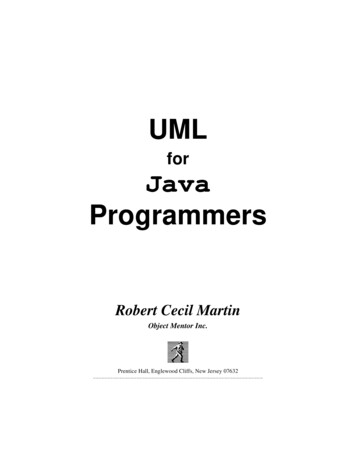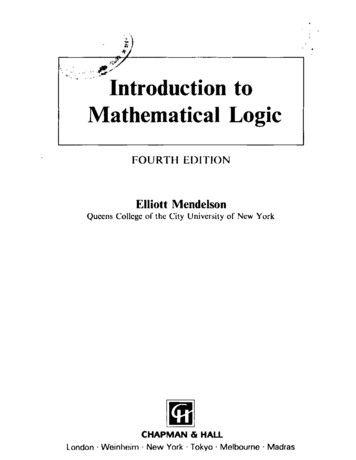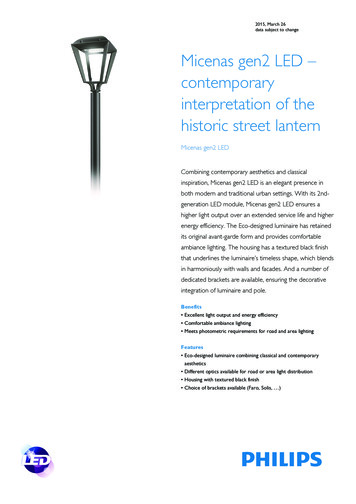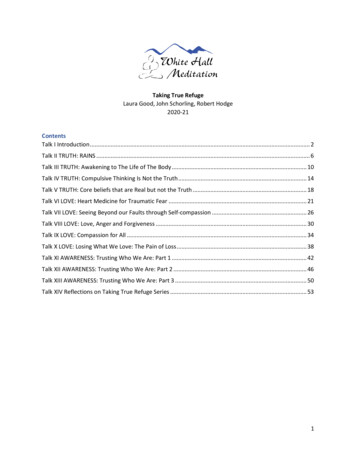
Transcription
Taking True RefugeLaura Good, John Schorling, Robert Hodge2020-21ContentsTalk I Introduction . 2Talk II TRUTH: RAINS . 6Talk III TRUTH: Awakening to The Life of The Body . 10Talk IV TRUTH: Compulsive Thinking Is Not the Truth . 14Talk V TRUTH: Core beliefs that are Real but not the Truth . 18Talk VI LOVE: Heart Medicine for Traumatic Fear . 21Talk VII LOVE: Seeing Beyond our Faults through Self-compassion . 26Talk VIII LOVE: Love, Anger and Forgiveness . 30Talk IX LOVE: Compassion for All . 34Talk X LOVE: Losing What We Love: The Pain of Loss . 38Talk XI AWARENESS: Trusting Who We Are: Part 1 . 42Talk XII AWARENESS: Trusting Who We Are: Part 2 . 46Talk XIII AWARENESS: Trusting Who We Are: Part 3 . 50Talk XIV Reflections on Taking True Refuge Series . 531
Talk I IntroductionRobert Hodge 10/21/2020They go to many a refuge,to mountains, forests,parks, trees, and shrines:people threatened with danger.That's not the secure refuge,that's not the highest refuge,that's not the refuge,having gone to which,you gain releasefrom all suffering and stress.But when, having gone for refugeto the Buddha, Dhamma, and Sangha,you see with right discernmentthe four Noble Truths —stress,the cause of stress,the transcending of stress,and the Noble Eightfold Path,the way to the stilling of stress:That's the secure refuge,that, the highest refuge,that is the refuge,having gone to which,you gain releasefrom all suffering and stress.— Dhammapada, 188-192This series is about how we can find freedom from stress by taking the true refuge. As noted above, theBuddha described three gateways to this refuge which are traditionally known as the Three Jewels orGems. We enter each of these gateways (in any order) to find that refuge, that place of peace andsafety.The inspiration for this series comes from True Refuge by Tara Brach1. We will explore other resourcesincluding the Buddha’s teachings (suttas).What is refuge?A refuge is defined as a condition of being safe or sheltered from pursuit, danger, or trouble. Tara notesthat when we suffer, we may seek false refuges: “They are false because while they may provide atemporary sense of comfort or security, they create more suffering in the long run. We might have afear of failure and take refuge in staying busy, in striving to perform well, or in taking care of others. Or2
we might feel unlovable and take refuge in pursuing wealth or success. Maybe we fear being criticizedand take refuge in avoiding risks and always pleasing others. Or we feel anxious or empty and takerefuge in alcohol, overeating, or surfing the Web. Instead of consenting and opening to what we areactually feeling, our turn toward false refuges is a way of avoiding emotional pain. But this only takes usfurther from real comfort, further from home.”2This series is about finding and taking true refuge. Tara notes: “The great gift of a spiritual path is comingto trust that you can find a way to true refuge. You realize that you can start right where you are, in themidst of your life, and find peace in any circumstance. Even at those moments when the ground shakesterribly beneath you—when there’s a loss that will alter your life forever—you can still trust that youwill find your way home. This is possible because you’ve touched the timeless love and awareness thatare intrinsic to who you are.Looking back through history, and across many religious and spiritual traditions, we can recognize threearchetypal gateways that appear again and again on the universal path of awakening. For me, the wordsthat best capture the spirit of these gateways are “truth,” “love,” and “awareness.” Truth is the livingreality that is revealed in the present moment; love is the felt sense of connectedness or oneness withall life; and awareness is the silent wakefulness behind all experience, the consciousness that is readingthese words, listening to sounds, perceiving sensations and feelings. Each of these gateways is afundamental part of who we are; each is a refuge because it is always here, embedded in our own being.If you’re familiar with the Buddhist path, you may recognize these gateways as they appear in theirtraditional order: Refuge in the Buddha (an “awakened one” or our own pure awareness) Refuge in thedharma (the truth of the present moment; the teachings; the way) Refuge in the sangha (the communityof spiritual friends or love)3In the Vera Sutta, the Buddha describes the Buddha, Dharma, and the Sangha: ‘Indeed, the Blessed Oneis worthy & rightly self-awakened, consummate in clear-knowing & conduct, well-gone, an expert withregard to the cosmos, unexcelled trainer of people fit to be tamed, teacher of devas & human beings,awakened, blessed.’‘The Dhamma is well taught by the Blessed One, to be seen here & now, timeless, inviting verification,pertinent, to be experienced by the observant for themselves.’‘The Saṅgha of the Blessed One’s disciples who have practiced well who have practiced straightforwardly who have practiced methodically who have practiced masterfully— they are the Saṅgha ofthe Blessed One’s disciples: deserving of gifts, deserving of hospitality, deserving of offerings, deservingof respect, the incomparable field of merit for the world.’43
As noted above, Tara describes the gateways as Truth, Love, and Awareness. This corresponds to thetraditional Buddhist tradition of the Dharma (Truth), the Sangha (Love) and Buddha (Awareness). Thethree gateways are also related to three divisions of the Eightfold Path: Wisdom (Truth), Conduct (Love),and Practice (Awareness). These relationships are shown below.BrachTruthLoveAwarenessTraditional BuddhismDharmaSanghaBuddhaEightfold PathWisdomConductPracticeFor the purposes of this series, we will be using Tara’s naming.One more aspect of the gateways: Tara notes: “How can we enter these gateways in our everydaylives? If you look again, you’ll see that each domain of refuge has both an outer and an inner aspect. Theouter expressions of the refuges are the sources of healing, support, and inspiration that we find in theworld around us. We can learn from wise teachings (truth). We can be nourished by the warmth of goodfriends and family (love). We can be uplifted by the example of spiritual leaders (awareness). Everyreligion and spiritual path offer these outer refuges. If we are willing to engage with them, they can offerus immediate, concrete help in living our daily lives. Yet each outer refuge also offers something more: Itis a portal to the inner refuges of pure awareness, the living flow of truth and boundless love. As weinhabit these expressions of our true nature, the trance of separation dissolves and we are free.5What does it mean to take refuge?As Tara described, there are three areas of refuge: truth, love, and awareness. We can choose ourgateway depending on what relief our suffering calls for. It’s like entering a large room with threesmaller conference areas labelled truth, love, and awareness. We can enter truth to find wisdom andunderstanding about the workings of the body and mind. We can enter love to address fear and angerand learn how to care for ourselves and others through compassion. We can enter awareness to seekthe support of the Buddha and other benefactors to strengthen our practice of mindfulness andmeditation.Outline of the SeriesBelow is a list of the talksIntroduction – Bob HodgeRAINS - John SchorlingThe Gateway of TruthAwakening to the Life of the Body - Laura GoodCompulsive thinking is Not the truth - LauraCore beliefs that are Real but not the Truth - John4
The Gateway of LoveHeart Medicine for Traumatic Fear - JohnSeeing Beyond our Faults through Self-compassion -BobLove, Anger and Forgiveness - LauraCompassion for all - JohnLosing What We Love: the Pain of Loss - LauraThe Gateway of AwarenessTrusting Who We Are (Parts 1-3) BobSummary Reflections– John, Laura, BobAs we explore the true refuge, it is important to commit to a daily meditation practice for about 30minutes each day. Below is one approach.1. Position: Sit up straight, feet parallel on the ground, eyes closed (can remain open but notforced, angled downward).2. Establish compassion: – make a deep wish – “May I do this practice to benefit myself andothers”3. Be Aware of your body – note the contact on the chair, etc., shift focus to the hands and thecontact of the hand with clothing, abdomen pressure of your waist.4. Deep Breaths: Take 3 slow deep breaths and then just focus on how the breath enters andleaves your nose. Observe the sensation. Don’t push the air, just let it be. Do this for a period oftime. If a thought, memory, or sensation arises, just note it and go back to observing the breath.5. Gratitude: Bring to mind three things in your life for which you feel grateful. They can be things,people, situations—anything. Slowly think of them one at a time, exploring why you are—orcould be—grateful for them. Feel the fullest sense of appreciation and gratitude for thosethings. (you can substitute a loving-kindness practice intermittently)6. Awareness: Just be, observing what arises in the mind. Like the clouds in the sky, let the thoughtsarise and fall away, noting their impermanence. Return to the breath if needed for calm.7. Establish compassion again: “May this practice serve to benefit myself and others”5
Talk II TRUTH: RAINSJohn Schorling 10/28/2020RAINS, which is the first chapter in the section of True Refuge titled “The Gateway of Truth”, is a wayof investigating the truth of the way things are, and getting out of the trance of thinking. We spendmost of our time engaged in cognitive activity, and often believe that we can think our way out ofinner turmoil. Yet our reactions to our circumstances and situations arise from below consciousawareness and thus just thinking them is often futile, and hence a trance. In order to untangle thisprocess, we must drop below it, into our present moment experience, into what Tara calls presence.RAINS is a very powerful process for doing this, and can be a path to insight. Much of mindfulnesspractice can be distilled to concentration and insight. Concentration practice helps stabilize theattention, and once we are able to do this, then we can really begin to pay attention to our presentmoment experience which can lead to insight. A regular meditation practice is essential to doing this.Whenever a difficult emotion arises, we can transform our relationship to it by practicing with RAINS, atool founded on mindfulness and compassion. For this series, we are using RAINS, Recognize, Allow,Investigate, Non-identification and Self-compassion, rather than RAIN. If you have read both TrueRefuge and Radical Compassion, you know that in the former, N stands for Non-identification andkindness is included as part of Investigation. In Radical Compassion, N stands for Nurture. We thinkboth are important, and so we will be using the acronym RAINS to include both rather than RAIN withone or the other.In formal mindfulness practice we keep our attention on the breath, unless some other experience is sostrong that it pulls us away from our anchor. Then we can choose to turn our attention to that otherexperience. One kind of experience that can pull us away is strong physical sensation; another is strongemotion, which, like physical sensation, can simply arise spontaneously. We may also find we are lost inrecurrent thoughts going over and over the same thing, ruminating. As Tara states in True Refuge“Recognition is seeing what’s true in your inner life. It starts the minute you focus your attention onwhatever thoughts, emotions, feelings, or sensations are arising right here and now. Some parts ofyour experience are easier to connect with than others.”6Perhaps we aren’t even aware of an emotion associated with the thinking. I work with many healthcareproviders who often work long hours with few breaks and have to learn to suppress physical sensationsand emotions just to get through the day. When I ask them to identify how they are feeling, often theycan’t say. As a result, I use a cheat sheet with a list of emotions that I give to people to help themidentify emotions. If you have difficulty identifying emotions, know that many others do too. It’ssomething that can take practice to learn.In order to understand and process emotions, we need to let them exist as they arise and not get stuckin additional complications of judgment, evaluation, preferences, aversion, desires, clinging, resistanceor other reactions. RAINS is not an easy practice because our inclination is to resist or avoid difficultemotions or to get lost in them. RAINS asks us to lean into the emotions mindfully and kindly. As wepractice with it, it becomes easier. You won’t have to laboriously think of each letter in the acronym;they become more or less automatic.6
Practicing with RAINS promotes greater clarity and calmness in the midst of difficulty, which in turnenables us to respond in wiser and kinder ways that can bring greater joy into our lives.The five components of RAINS are:R—Recognize your present moment experience“You can awaken recognition by simply asking yourself, what is going on inside me right now?”7 It can behelpful to bring a sense of curiosity to doing this. You can try naming whatever you notice: this is (fear,anger, etc.). Don’t try to avoid or ignore. Often, we judge a difficult emotion as cowardly and try to bearup under it with a stiff upper lip. Or we’re so resistant that we don’t look at all; we change the subject.A—Allow the difficult emotion to be present without judgmentAllow whatever arises to just be, including letting emotion(s) be present, knowing that in mindfulnesspractice any emotion is OK. To the degree possible, allowing includes meeting the emotion with anattitude of kindness, friendliness, interest, curiosity. Our resolve to “allow” an emotion can besupported with phrases whispered in the mind, “it's like this,” "yes,” “this too.”I—InvestigateSometimes the first two steps are enough to reconnect us with presence. At other times, the attentiongets carried away over and over again. If so, we can lean into the difficult emotion, noticing if we’recatastrophizing, building a negative story based on “what ifs,” things that haven’t happened and maynot; drop the storying and mindfully return to the present moment. If we can mindfully return to thepresent, there is nothing more to do. But if the difficult emotion persists, we can take the attention intothe body and notice the physical sensations that have been triggered by the emotion. We might evenput our hand on the spot.We might also ask ourselves simple questions. Tara suggests “How am I experiencing this in the body?”,“What is happening inside me?”, “What most wants attention?”, and “What am I believing?” In askingthe latter question, it’s important to notice the tendency to get lost in thinking, to start a story about thebeliefs. Rather, stay with whatever first arises, such as “I’m believing I’m not good enough,” noticingyour experience in just being with this.N—Non-identificationThis is a key factor in this process, and in this path. In Buddhism, non-self is one of the three marks ofexistence, (anatta). The other two are suffering (dukkha) and impermanence (anicca). Non-self refers tothe absence of a distinct separate solid self; that is, we are all the product of multiple causes andconditions, which are constantly changing. From a physiologic point of view, this is demonstrably true.Most cells in our bodies turn over in a matter of days to months. Even neurons in our brains which arelong-lived are constantly rewiring. As a result, we are not our bodies, we are not our thoughts, and weare not our difficult emotions.To practice non-identification, we can take a step back, remembering that the thoughts, sensations andemotions that are present don’t define us. Each of us is more and other than them. We can viewwhatever is arising as the (fear, anger, anxiety, etc.), not my (fear, anger, anxiety, etc). It is the emotion,7
not my emotion; the thought, not my thought. You might also respond by saying “not me” or “not mine”to whatever is arising. This can be empowering.S—Self-compassionSelf-compassion can permeate all of RAINS or be cultivated separately. Responding to yourself as youwould a dear friend with warmth and caring – perhaps with a hand on the heart, you might say one ofthese phrases to yourself, “This is a moment of suffering; may I be kind to myself; may I give myself thecare I need; may I hold myself with tenderness.”RAINS can be used any time when an emotion becomes prominent, during formal mindfulness practiceor in any moment of one’s daily life when strong emotions are present. If something has been botheringus, we might have the intention of paying attention to it during formal meditation, what we refer to as“sitting with it”. At other times, we may have the intention of paying attention to the breath whilemeditating, and we notice that a strong emotion is arising, or there is some sense of dis-ease in thebody. If that is the case, we might make this the object of our meditation using RAINS.So, let’s explore this using RAINS as the focus of a meditation.Finding a comfortable position, eyes open or closed as you prefer. Bringing attention to the body,noticing the weight of the body sitting, having some sense of being grounded, of being connected withthe earth. Let your attention settle in on your anchor, whether it is sound, the breath or other bodilysensations.Now let the anchor recede into the background and bring to mind a recurrent situation when you knowyou will have a strong reaction. Notice the details of this episode. What thoughts arise? Bringingattention to the feelings, what is the predominate emotion?Recognize what is happening inside you. If there is a predominant emotion, is it possible to name it?“this is anger” or “this is disappointment”. It may not be obvious what the emotion is, and if so that’sfine.Just Allow your experience to be, without judging it or needing to fix it or make it go away. If this is toodifficult, then directing the attention elsewhere is fine, back to the breath or perhaps to the feet orhands. You might try saying “yes” or “just let this be” to yourself.If you are able to be with the emotion, then Investigate it, noticing where you feel it in the body, andthe characteristics of the associated sensations.You can also choose to investigate further the source of this feeling, asking yourself “How am Iexperiencing this in the body?” Notice the physical sensations that are arising. You might also ask“What most wants attention?”, and “What am I believing?”Whatever is arising, see if it’s possible to just be with it without judging as it is a result of multiple causesand conditions, so not Not identifying with it, the N of RAINS. It does not define you – you are more andother than this. It may be useful to acknowledge this by saying to yourself “not me” or “not mine”.8
Being with difficult emotions is hard, and practicing Self-kindness and self-compassion can be veryhelpful. You might do this by responding to yourself as you would to a friend, with warmth and caring,and by answering the question “what do I most need now?”Often there is a tendency to close down around difficult emotions, so it can be helpful to visualize themheld in a larger space. Awareness is vast, so visualizing holding these beliefs and emotions in a largerspace can be helpful, even bigger than the physical self. You can also envision how your wisest selfwould respond, or you can imagine how a spiritual figure would respond to your suffering.Just sit with this now, holding whatever is arising with spaciousness, compassion, and kindness.When you are ready, letting go any images being held in the mind and returning the attention tobreathing, or wherever else you might choose as an anchor. Resting the attention there and justbreathing, and then opening the eyes once again if they have been closed.Take a few moments now to notice the quality of presence. Whatever arises is ok.RAINS can be practiced as a formal meditation as we just did. It can also be used in the moment. Taracalls this “taking a U turn” from an outward focus to what’s happening right now. A briefer version fordoing this is: Recognize what is happening Allow your experience to be just as it is, perhaps taking a few deep breaths Investigate inner experience (thoughts, sensations, feelings) with kindness Now proceed with awarenessAn example of this for me is traveling. I found I was often triggered by experiences of feeling I was notlistened to or respected by airline agents or flight attendants, thinking how they “should” respond tome. So I practiced recognizing when this happened, noticing how I was feeling. And I would just allowthis to be, without reacting. Then I investigated, noticing where I felt it in my body, usually as atightness in my chest, and I asked what I was believing. The answer was that I perceived a lack ofrespect, so I asked why did I feel this, and underneath found a feeling of insecurity, of not being heard.Noticing this, I did not identify with it as defining me, but rather as a transient state that would pass, andI was able to respond with kindness, an acknowledgment that this was not pleasant. In doing thisrepeatedly, I found myself much less likely to get triggered in these situations.Both chapters on RAIN in True Refuge and Radical Compassion start with the same quote that is oftenattributed to Viktor Frankl. He was an Austrian Jewish psychiatrist who survived being in aconcentration camp in WWII:“Between the stimulus and the response there is a space and in that space lies our power and ourfreedom.”8RAINS is a way of exploring this space between stimulus and response, of learning to respond and notjust react.9
Talk III TRUTH: Awakening to The Life of The BodyLaura Good 11/4/2020From The Way of the Bodhisattva by Shantideva, an 8th-century CE Indian philosopher, Buddhist monk,poet and scholar at the University at Nalanda.What we call the body is not feet or shins,The body, likewise, is not thighs or loins.It’s not the belly nor indeed the back,And from the chest and arms the body is not formed.The body is not ribs or hands, Armpits, shoulders, bowels, or entrails;It is not the head or throat:From none of these is “body” constituted.If “body,” step by step,Pervades and spreads itself throughout its members, Its parts indeed are present in the parts,But where does the “body,” in itself, abide!If “body,” single and entire,Is present in the hand and other members,However many parts there are, the hand and all the rest, You’ll find an equal quantity of “bodies.”If “body” is not outside or within its parts, How is it, then, residing in its members? And since it has nobasis other than its parts, How can it be said to be at all?Thus there is no “body” in the limbs,But from illusion does the idea spring,To be affixed to a specific shape—Just as when a scarecrow is mistaken for a man.As long as the conditions are assembled, A body will appear and seem to be a man. As long as all theparts are likewise present, It’s there that we will see a body.Likewise, since it is a group of fingers, The hand itself is not a single entity.And so it is with fingers, made of joints— And joints themselves consist of many parts.These parts themselves will break down into atoms, And atoms will divide according to direction.These fragments, too, will also fall to nothing.Thus atoms are like empty space—they have no real existence.All form, therefore, is like a dream,And who will be attached to it, who thus investigates! The body, in this way, has no existence9Tonight, we are going to talk about the body and how we can use it to open to a deeper understandingof reality and how it can bring us freedom.In the Samyutta Nikaya, the Buddha says, “This body is not mine or anyone else’s. It has arisen due topast causes and conditions.”As John talked about last week, just as our mind is rarely static, neither is our body. We are made up oftrillions of cells that are continually dying and being reborn all at different rates. We really are never the10
same person moment to moment. And this ever-changing biological organism that we call ourselves, issubject to the laws of nature on this planet – we are born, we are subject to illness, pain and death. Oras Wes Nisker says “this body is not ours; it is evolution’s body. The body we live in is a loaner.”10 Orrather our cells are doing a dance, a complicated, choreographed dance.But it is what we have. Our body is the house for our brain and what we call our mind. Though our mindis how we think we are processing all the events of life, like it or not it is our body that feels what’s goingon. It’s our body that is continually sensing and messaging our brain through our six sense doors (ears,eyes, nose, tongue, body, mind), then the mind reacts.Our brain may tell us whether what we are experiencing is pleasure or pain or neither, but it is just theinterpreter. What our body is sensing is plain physics, just as Shantideva was saying in the meditation.Atoms are buzzing all around, an object touches our skin, we don’t stop at sensing “feeling”-- we needknow – friend or foe, for our own survival. Our perception kicks in and we are now subject to a ministory, based on past experience, about how we feel in regards to that sensation. And if we perceive thisfeeling as negative, we suffer. And when we suffer, we tend to want to push it away and make it stop.But in Buddhism, even positive feelings can cause suffering. Maybe you are working on your feet all dayand you think, “I so look forward to getting home and just lying down, But if you lie down for too long, itgets uncomfortable”. We get pleasure at first from sitting down and then after a while too much sitting!Too many zoom meetings! Now I just want to stand up and so on.So our craving, tanha (Pail word referring to "thirst, desire, longing, greed", either physical or mental)causes us to want the pleasure to last and pain to go away that is arising from vedana, sensation of thebody. The Buddha truly was a scientist. Everything that arises in the mind arises with the sensations onthe body and these sensations are the material we have to work with.So how do we work with the body so we may experience freedom?The Buddha gave us the instructions. Vipassana practice is based on the Mahasatipatthana Sutta (TheFour Foundations of Mindfulness).11 More than 2,600 years ago, the Buddha exhorted his seniorbhikkhus, monks with the responsibility of passing his teachings on to others, to train their students inthe Four Foundations of Mindfulness: Mindfulness of the body, the feelings, the mind and the dharma.“And how does a monk remain focused on the body in and of itself?“There is the case where a monk—having gone to the wilderness, to the shade of a tree, or to an emptybuilding—sits down folding his legs crosswise, holding his body erect and setting mindfulness to the fore(front of chest0. Always mindful, he breathes in; mindful he breathes out.“Breathing in long, he discerns, ‘I am breathing in long’; or breathing out long, he discerns, ‘I ambreathing out long.’ Or breathing in short, he discerns, ‘I am breathing in short’; or breathing out short,he discerns, ‘I am breathing out short.’ He trains himself, ‘I will breathe in sensitive to the entire body’;he trains himself, ‘I will breathe out sensitive to the entire body.’ It goes on to the specific parts of thebody.11
“And further, when walking, the monk discerns, ‘I am walking.’ When standing, he discerns, ‘I amstanding.’ When sitting, he discerns, ‘I am sitting.’ When lying down, he discerns, ‘I am lying down.’ Orhowever his body is disposed, that is how he discerns it.“In this way he remains focused internally on the body in and of itself, or externally on the body in andof itself, or both internally and externally on the body in and of itself. he remains independent,unsustained by [not clinging to] anything in the world. This is how a monk remains focused on the bodyin and of itself.It sounds simple, but until we actively focus on the body, do we really pay attention day to day? Onlywhen it hurts, or when we feel good and energetic. Whatever we are paying attention or not, the bodyis.Even though our mind may be wandering, somewhere in the body we are tensing or, slightly rigid in thebreath. If we can focus on the sensations in the body without reacting, we can soften. The softening canfeel like a release, which can be scary as well as the sensations can get more intense at first. This iswhere the freedom lies when we do not push away the experience.But
Buddha described three gateways to this refuge which are traditionally known as the Three Jewels or Gems. We enter each of these gateways (in any order) to find that refuge, that place of peace and safety. The inspiration for this series comes from True Refuge by Tara Brach1. We will explore other resources including the uddhas teachings (suttas) .
